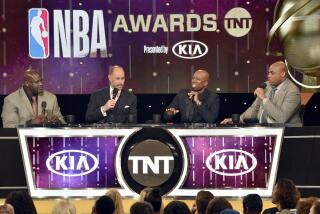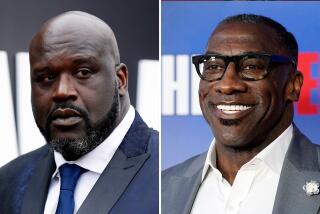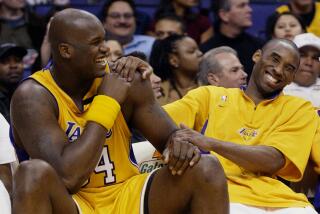That a Nice Guy Is Finishing at All Makes O’Neal’s Story a Good One
- Share via
Once in a while, something particularly nice happens to someone particularly deserving and causes a particularly good feeling that transcends a seemingly routine moment and makes it special.
It happened last Sunday to Leslie O’Neal.
He trotted onto a football field and took his stance at the end of the Chargers’ defensive line.
I know, thousands of young men do this every weekend across America. O’Neal himself had done this dozens of times for Hall High School in Little Rock, Ark., and Oklahoma State University and the Chargers. No big deal, right?
Wrong.
To be precise, O’Neal trotted onto a football field for a game exactly 13 times for the Chargers in the fall of 1986. That 13th was the fall of Leslie O’Neal. He was hauled off the field that Sunday afternoon in Indianapolis, his left knee a tangled mess of tattered and battered ligaments.
Dreaded words would be said over that knee.
“Torn medial collateral ligaments,” doctors said, “and torn anterior cruciate ligaments.”
A career went thud less than 13 games into its first year.
Later, when O’Neal was named the NFL’s defensive rookie of the year, it seemed almost as much an epitaph to a career as an honor.
Brave words were spoken in the aftermath of the required surgery. Maybe he would not be back for 1987 training camp, but he surely could play by early in the season. Later, it was deemed more likely that he might return later in the season. The later kept coming and going, and O’Neal himself finally concluded that he just didn’t know when later might come.
“I was young and immature trying to predict when I’d be back,” O’Neal conceded this week. “Never having been hurt to that extent, I looked at a year, and I figured that was enough time to heal or do anything. I didn’t know what I was about to go through. I didn’t know the damage that had occurred.”
I ran into O’Neal in spring of 1987 at a charity bowling tournament. O’Neal had the disposition of a guy dancing down Primrose Lane. Nothing about him suggested that this was a man dealing with a painful present and an uncertain future. He was Mr. Congenial.
Except he could hardly move.
O’Neal would gingerly retrieve his ball, cradle it in his arms and shuffle slowly to the foul line. He would stop there, bend at the waist and roll the ball down the alley. He was all arm and heart.
Sean Jones, then with the Raiders, was on the next lane. He was robust and mobile. Leslie O’Neal set out to beat him . . . and did.
This was a tipoff. There was a fire burning in this man. He would be back.
It would be tough, and maybe it would not be as quickly as he hoped and dreamed. But he would be back.
“The mental part was the toughest,” he said. “I had to make progress, but I had to understand that progress and not go overboard trying to do more and more. I had to maintain controls so I wouldn’t hurt the progress I was making by trying to go too far.”
But it was so tempting. He was so swift and agile, and he was such a defensive presence that he had already made 12 1/2 sacks by the time he went out on the fateful Sunday in Indianapolis. He made it look so easy, and now it was so hard.
“There were times,” he confessed, “that I had doubts whether I could come back. I had to get where I wasn’t worried about when I might come back and take things more day to day. I wanted to make sure I was as effective as I was when I left.”
Not only could he not play football by early in the 1987 season, he could not run early in the 1987 season. It was last November before he could start running as much as a little bit. Significantly, running and running fast enabled him to be the impact player he had been.
Realistically, he considered other alternatives. He considered bulking up and coming back as a power player rather than a finesse player. He thought maybe he could get by with his mind rather than his quickness. He thought about switching to nose guard.
That was one of the problems. The physical outlet was gone, and he had so much time to think. That was why the mental side of coming back was so much more difficult than the physical, and the physical was bad enough.
And then came news that Leslie O’Neal was practicing. Frankly, I expected that this was maybe a half-speed exercise to give him a head start on 1989. But it was followed soon thereafter by news that he would be activated for last week’s trip to Miami.
O’Neal was not sure what to expect, but not from himself.
“I expected Miami to come out and test me at the line of scrimmage,” he said, “rather than lay up and wait for a move. Instead, the guy studied me and backed away. That made me feel good. I took it as a compliment.”
And O’Neal felt better as the game progressed.
“I saw glimpses of the same player that left the game 2 years ago quite a bit in the fourth quarter,” he said. “I didn’t see the same player in the first quarter or the first half, but I started to feel like I still have the same athletic ability and instincts and moves. I just have to get to the point where I can really react, and I’m really comfortable in the stress zone.”
Of course, the Leslie O’Neal of today is not yet the Leslie O’Neal of 2 years ago. That would be too much to expect, maybe so soon and maybe forever.
“But,” said defensive coordinator Ron Lynn, “he will be an outstanding player in this league if he can come back to even a reasonably high percentage of what we think he can become.”
That’s the nicest thing about Leslie O’Neal and where he is today. He is on the football field, and talk is of how good he can become rather than whether he will ever again play this game he plays so well. And that now is the appropriate word. Plays .


